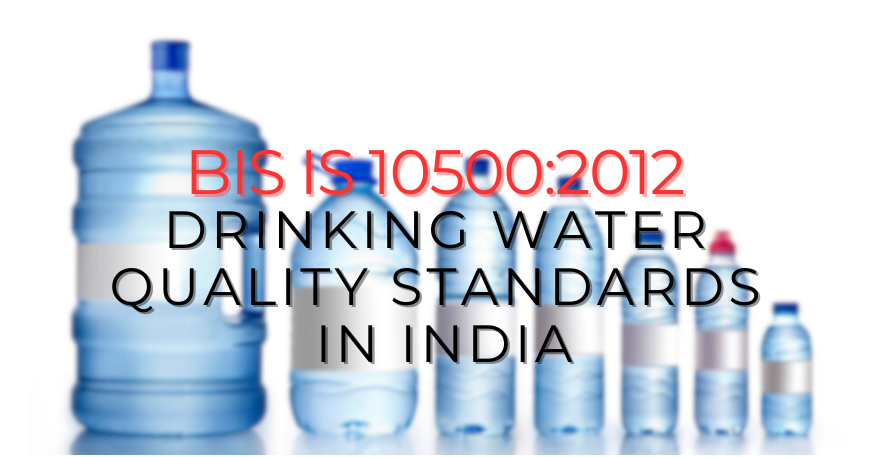The quality of drinking water is crucial for public health. In India, the Bureau of Indian Standards (BIS) sets the drinking water quality standards under IS 10500:2012. These standards serve as a benchmark for ensuring safe and clean drinking water, which is essential for the well-being of the population. This blog delves into the details of BIS IS 10500:2012, the parameters for water quality, and its significance in urban and rural contexts, with examples of tier-1 and tier-2 cities in India.
Understanding BIS IS 10500:2012
BIS IS 10500:2012 specifies the acceptable and permissible limits of various contaminants and substances in drinking water. These standards are divided into two categories:
Acceptable Limits: Safe limits of substances in water, beyond which it may not taste or appear appealing.
Permissible Limits in the Absence of Alternate Sources: Limits that are safe for consumption when no alternative source of water is available.
The standards cover physical, chemical, biological, and radiological parameters, ensuring comprehensive water safety.
Key Parameters of Drinking Water Quality
The parameters outlined in BIS IS 10500:2012 can be broadly categorized as follows:
1. Physical Parameters
These include the characteristics of water that affect its appearance and palatability:
Parameter | Acceptable Limit | Permissible Limit |
|---|---|---|
Turbidity (NTU) | 1 | 5 |
pH Value | 6.5 to 8.5 | No relaxation |
Colour (Hazen Units) | 5 | 15 |
Taste and Odour | Agreeable | Agreeable |
2. Chemical Parameters
These parameters monitor the presence of chemical substances that can affect health:
Parameter | Acceptable Limit (mg/L) | Permissible Limit (mg/L) |
|---|---|---|
Total Dissolved Solids (TDS) | 500 | 2000 |
Chloride | 250 | 1000 |
Sulphate | 200 | 400 |
Nitrate | 45 | No relaxation |
Fluoride | 1.0 | 1.5 |
Iron | 0.3 | No relaxation |
Lead | 0.01 | No relaxation |
3. Biological Parameters
The presence of pathogens and microorganisms can cause severe health issues:
Parameter | Requirement (Acceptable) | Test Method |
|---|---|---|
E. coli or Thermotolerant Coliform bacteria | Must not be detectable in 100 mL sample | IS 1622 |
Total Coliforms | Must not be detectable in 100 mL sample | IS 1622 |
4. Radiological Parameters
These parameters are rare but essential in areas with potential radiological contamination:
Parameter | Acceptable Limit | Permissible Limit |
|---|---|---|
Gross Alpha Activity | 0.1 Bq/L | No relaxation |
Gross Beta Activity | 1.0 Bq/L | No relaxation |
Importance of BIS IS 10500:2012
Health Protection: Prevents waterborne diseases by ensuring microbiological safety.
Guideline for Water Treatment: Acts as a reference for designing and operating water treatment facilities in cities like Delhi, Mumbai, Chennai, and Hyderabad.
Environmental Sustainability: Encourages the preservation of water resources by monitoring pollution levels.
Challenges in Maintaining Drinking Water Quality
Urban Areas
In tier-1 cities such as Bengaluru, Pune, and Kolkata, challenges include:
- High levels of industrial discharge.
- Overburdened municipal water systems.
- Contamination from aging pipelines.
Rural Areas and Tier-2 Cities
In tier-2 cities like Jaipur, Lucknow, and Surat, challenges include:
- Limited access to advanced water treatment facilities.
- High dependence on groundwater, which may contain excess fluoride or nitrates.
- Seasonal contamination due to flooding or droughts.
Compliance and Monitoring
Ensuring compliance with BIS IS 10500:2012 involves:
- Regular Testing: Urban local bodies in cities like Ahmedabad and Bhopal routinely test water for compliance.
- Public Awareness Campaigns: Educating citizens on the importance of water quality.
- Upgrading Infrastructure: Investment in modern water treatment plants in cities like Coimbatore and Kochi.
Drinking Water Quality in Indian Cities
Here is an overview of drinking water quality across various Indian cities:
City | Key Issues | Initiatives |
|---|---|---|
Delhi | High ammonia levels | Water treatment plant upgrades |
Mumbai | Seasonal bacterial contamination | Advanced filtration systems |
Chennai | Salinity in groundwater | Desalination plants |
Hyderabad | Fluoride contamination | Rural water supply programs |
Bengaluru | High TDS levels | Public-private partnerships for water quality |
Jaipur | Nitrate contamination | Groundwater management plans |
Role of Government and Local Bodies
The government plays a crucial role in implementing BIS IS 10500:2012. Key initiatives include:
National Water Quality Monitoring Programme (NWQMP): Monitors water quality in rivers and lakes.
Atal Mission for Rejuvenation and Urban Transformation (AMRUT): Focuses on improving water supply in 500 cities.
Jal Jeevan Mission: Ensures safe drinking water to rural households.
Conclusion
The BIS IS 10500:2012 standards are a cornerstone for ensuring the safety and quality of drinking water in India. With rapid urbanization in tier-1 cities like Mumbai, Delhi, and Bengaluru, and growing populations in tier-2 cities like Surat, Lucknow, and Patna, adherence to these standards is critical. Regular monitoring, public awareness, and infrastructure upgrades are essential to provide safe and clean drinking water to all citizens.
Addressing the challenges and leveraging technology and government programs can bridge the gap in water quality management, safeguarding public health and fostering sustainable development.





